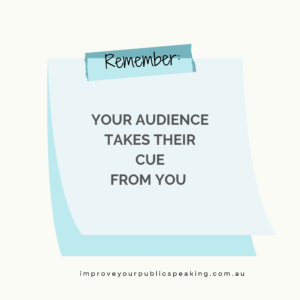Want to engage your audiences more effectively?
Remember this key point: the audience nearly always takes their cue from us.
If we want them to be more than just informed by our presentation – and we usually do – we need to enable them to follow our lead easily. To motivate, lift, persuade or inspire…all of these need us as the speaker to model that behaviour.
I’m not talking about being over the top – unless that’s your style. Often quite subtle tweaks make all the difference. Here’s how to think of it:
An example from music
I once worked with a conductor (in my previous career as a classical pianist) who told me:
“what they see is what you get“.
The conductor meant this: the body language and facial expressions that they choose – what non-musicians see as ‘waving their arms around’ – has a big impact on how the group is cued to play or sing.
That’s a big part of any conductor’s job: audience engagement. And as the person at the front of the room speaking, we can see our role as similar. Whatever level of topic engagement, energy, or enthusiasm we display is going to have an effect on our audience and their focus and beliefs around our topic or content.
If we’re the slug up the front, our audience doesn’t stand a chance! And that’s not much of an exaggeration by the way”. I’m not sure about you, but I’ve seen plenty of speakers with tiny levels of topic engagement.
We can’t expect any audience to come along with us if we’re not effectively leading them in that direction.
How this applies to speakers
When you speak or present to a group, if you’re low-energy or look disengaged or distracted, this happens: your audience eventually responds similarly.
The same applies if you’re the opposite, bouncing around with nervous energy. That jitteriness translates to them.
When doesn’t this apply?
When what you do is totally the opposite of what they want from the speaker; this can trigger audience members to deliberately go the other way.
For example, an OTT motivational speaker constantly raising their hand while asking questions to try and keep us entertained…that can quickly wear out its welcome from quieter low-key audience members, who simply stop responding.
How to apply this idea intentionally
Think about your:
- Mood
- Energy levels
- Facial expressions
Before and during (if you can) your presentation or talk, and ask yourself this:
‘Am I “cuing” the audience in the best ways to achieve the results I – and they – are looking for?’
Something to think about, if you want to get the best outcomes possible. What do you think?
More posts you might like on this topic: energy reach. Smiling and the signals it sends.
Best wishes with your presentations or public speaking!


Leave a Reply